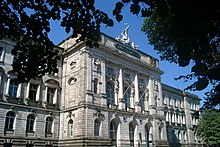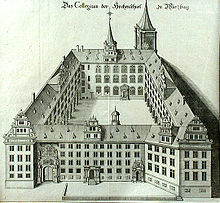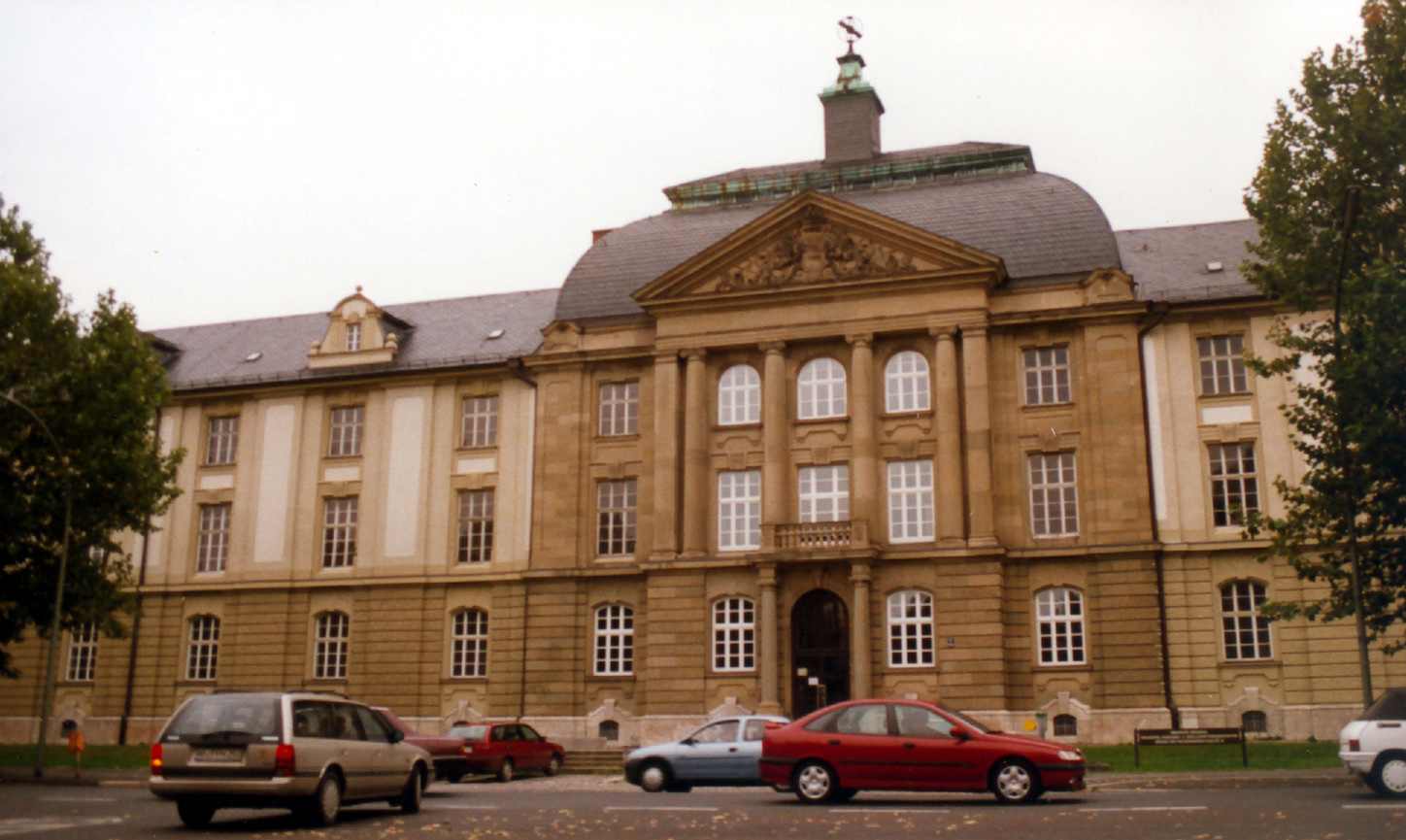Wurzburg University
| Julius-Maximilians-Universität Würzburg | |
|---|---|
 | |
| Established | 1402 (closed 1415—1582) |
| Type | Public |
| President | Prof. Dr. Alfred Forchel |
| Undergraduates | 22.128 (term 2010/11) |
| Postgraduates | 3,100 |
| Location | Würzburg, Germany |
| Campus | Urban |
| Mascot | none |
| Website | http://www.uni-wuerzburg.de/en/home/ |
The University of Würzburg is a university in Würzburg, Germany, founded in 1402. The university is a member of the distinguished Coimbra Group.
The University’s official name is Julius-Maximilians-Universität Wurzburg which translates to Julius-Maximilian's University of Würzburg but it is commonly referred to as the University of Würzburg. This name is taken from Julius Echter von Mespelbrunn, Prince-Bishop of Würzburg, who reestablished the University 426 years ago, and Prince Elector Maximilian Joseph, the prince under whom secularization occurred at the start of the 19th century. The University’s central administration, foreign student office, and several research institutes are located within the allied area of the old town, while the new liberal arts campus, with its modern library, overlooks the city from the east. The University today enrolls approximately 22,000 students, out of which more than 1,000 come from other countries.
History

1402

Although the University was first founded in 1402, it was short-lived. The original university was destined to flounder. This was attributed to the lack of financial security and the instability of the age. Johannes Trithemius, well-known humanist and learned abbot of the Scottish monastery of St. Jacob, held the then dissolute student lifestyle responsible for the premature decline of the city's first university. In the 'Annales Hirsaugiensis Chronologia Mystica' of 1506 he cites bathing, love, brawling, gambling, inebriation, squabbling and general pandemonium as 'greatly impeding the academic achievement in Würzburg'. Confirmation of this point of view is found in the fatal stabbing of the university's first chancellor, Johann Zantfurt, in 1423 by a scholar's unruly assistant, or 'famulus', evidently the result of these very influences. Despite Egloffstein's thwarted first attempt at founding a university, the city still boasts one of the oldest universities in the German-speaking world, on a par with Vienna (1365), Heidelberg (1386), Cologne (1388) and Erfurt (1392).
1545—1945
The initial inauguration of a university in Würzburg would ultimately not be resumed until a hundred and fifty years later. A 'second founding' by Prince Bishop Julius Echter von Mespelbrunn (1545–1617) in 1582 was to augur well for a 'new' university whose autonomous self-government was guaranteed. Politically speaking, the university was fiercely Roman Catholic and initially considered 'a bastion of Catholicism in the face of Protestantism', words also used in the university charter which prevented all non-Catholics from graduating from or receiving tenure at the 'Alma Julia'.
Over a century would pass before the university would deign to open its doors to non-Catholics, in keeping with the spirit of Enlightenment encouraged by Prince Bishop Friedrich Carl von Schönborn's newly formulated students' charter of 1734. The resultant increase in religious tolerance even enabled the summoning and subsequent appointment of the famous physician, Carl Caspar von Siebold, under Schönborn's successor, Adam Friedrich von Seinsheim. Shortly after his arrival in 1769, Protestant medical students were permitted to study for their doctorates at the university.
Würzburg's increasing secularisation as a bishopric and its eventual surrender to Bavarian rule at the beginning of the nineteenth century resulted in the inevitable loss of the university's Roman Catholic character. The end of the city's status as a Grand Duchy under Ferdinand of Toscana in 1814 heralded the 'Alma Julia's' ideological transition to the non-denominational establishment which endures to this day. This new inclusiveness towards professors and students alike was instrumental in the resultant unexpected upturn in all areas of research and education in the nineteenth century. Since then, the university has borne the name of its second and most influential founder, officially known as the Julius-Maximilians-Universität of Bavaria.
The many medical accomplishments associated with the university from the mid- to late nineteenth century were inextricably linked with achievements in the affiliated field of natural science, notably by Schwab, the eminent botanist, Semper, the zoologist, Wislicenus, the celebrated chemist and Boveri, the biologist. Their progress culminated in the discovery of x-rays by physicist Wilhelm Conrad Röntgen, first winner of the Nobel Prize for Physics, in 1895. Röntgen's discovery, which he dubbed 'a new kind of ray', is regarded as the university's greatest intellectual achievement, and, simultaneously, a scientific development of huge global import. Röntgen's successors, namely Wilhelm Wien, Johannes Stark and the chemists Emil Fischer and Eduard Buchner, also number among the succession of Nobel Prize winners to lecture at the university, a tradition which endures in the present-day example of Klaus von Klitzing.
1945 to today
After the Second World War, the free state of Bavaria invested many millions of German marks in the rebuilding and renovation of the severely damaged university buildings. Restoration of Echter's 'Old University', current home to the faculty of law, continues today. The eventual rebuilding of the Neubaukirche ('Neubau Church'), also affiliated to the legal faculty and almost razed to the ground in 1945, marked the end of the city's extensive reconstruction process. In 1970 it was decided that the church, one of the most important examples of sixteenth century vaulted architecture in Southern Germany, should fulfil a dual function as a place of worship and as the university banquet, assembly and concert hall. Nevertheless, the dignity of Echter's original Renaissance church has been successfully maintained, and thus it is fitting that his heart, removed for safe-keeping during the war, has once again found its place in the church he designed, fulfilling a request made during his lifetime.
Faculties
- Faculty of Catholic Theology
- Faculty of Law
- Faculty of Medicine (Human Medicine, Dentistry and Biomedicine)
- Faculty of Arts I: History, Modern Languages, Culture and Geography
- Faculty of Arts II: Philosophy, Psychology, Educational and Social Sciences
- Faculty of Biology
- Faculty of Chemistry and Pharmacy
- Faculty of Mathematics and Computer Science
- Faculty of Physics and Astronomy
- Faculty of Economics
Quality in Diversity
Looking back at the development of the university from the original four faculties (Theology, Law, Medicine, and Philosophy) to today's ten faculties, one can see a widened spectrum of opportunities that offers students balanced, broad, and high-quality courses of study.
- 1582: The university opens its doors with departments of Theology and Philosophy and soon expands to include schools of Law and Medicine.
- 1878: The Faculty of Philosophy is divided into the histirico-philosophical and mathematical-scientific departments.
- 1937: The mathematical-scientific department becomes the university's fifth faculty.
- 1968: The Faculty of Law and Political Science is divided into two separate entities: the School of Law and the Faculty of Economics. At this point the university is comprised of six faculties.
- 1972: The former College of Education is integrated into the university as the Faculty of Education.
- 1974: As a result of governmental reforms issued for all institutes of higher education in Germany, the university is restructured to include 13 faculties.
- 1977: The Department of Education is dissolved and the 12 remaining faculties are integrated into the current university structure.
- 2007: The university is restructured to include ten faculties.
Nobel laureates
For research done at the University
- 1901 Wilhelm Conrad Röntgen (Physics)
- 1902 Emil Fischer (Chemistry)
- 1907 Eduard Buchner (Chemistry)
- 1919 Johannes Stark (Physics)
- 1922 Wilhelm Wien (Physics)
- 1935 Hans Spemann (Medicine)
- 1985 Klaus von Klitzing (Physics)
- 1988 Hartmut Michel (Chemistry)
- 2008 Harald zur Hausen (Medicine)
Associated with the University
- 1903 Svante Arrhenius (Chemistry)
- 1909 Ferdinand Braun (Physics)
- 1914 Max von Laue (Physics)
- 1920 Walther Hermann Nernst (Chemistry)
- 1930 Karl Landsteiner (Medicine)
 Lecture Hall for Natural Sciences
Lecture Hall for Natural Sciences Central University Library
Central University Library Center of Operative Medicine
Center of Operative Medicine
Old University
 Building Wittelsbacherplatz
Building Wittelsbacherplatz Biocenter
BiocenterA History of Success
The roots of the Julius Maximilian University of Würzburg reach back as far as 1402 AD. In that era, it was the sixth institution of higher learning to be founded in the German-speaking regions of Europe, after the Universities of Prague, Vienna, Heidelberg, Cologne, and Erfurt.
Nobel Laureates
Many eminent scholars and scientists, 14 Nobel Laureates among them, have researched and taught in Wurzburg. Rudolf Virchow, Carl Siebold, and Franz Brentano are in that number, as well as Wilhelm Conrad Rontgen, who discovered X-rays at Würzburg in 1895, or Klaus von Klitzing, discoverer of the Quantum-Hall Effect.
Today, Würzburg's university is counted among the medium-sized institutions of higher learning in Germany. At ten faculties, about 400 professors teach around 24,000 students.
An Extensive Choice of Subjects
Having grown over more than six centuries, the course catalog of the University of Würzburg offers a wide range of subjects. Many new study programs have been added to the list of the classic four – Medicine, Theology, Philosophy, and the Law. The most recent are Nanostructure Technology, Technology of Functional Materials, Biomedicine, Modern China, the FOKUS Physics Bavarian Excellence Program, Media Communications, Human Factors in Computing Systems and Museology – to name but a few.
The University of Würzburg remains clearly and strongly committed to the Four Pillars – The Humanities, the Law and Economics, Life Sciences, Natural Science and Technology.
A Policy of Expansion
It is not only the list of study options that has grown over the years. The University itself has been expanding continuously. The generous grounds of Hubland Campus are situated on a hill at the eastern edge of the city. Newly-designed study programs and the steady influx of students continue to drive the institution's growth. In 2011, the University has started to spread over the Campus Nord, a 39-hectare area which directly borders on Hubland Campus.
Würzburg University holds a position among the leading institutions in Germany – this is verified by the rankings of domestic and international research organizations and of international expert committees. On an international level as well, the University of Würzburg rates in the top bracket of academic institutions in many disciplines of science, for instance, in Biology, Medicine, Physics, and Psychology.
Research Centers as a Trademark
As early as in the 1990s, the University began founding cross-faculty research centers, opening up new subjects for investigation and research and innovative study programs. These interdisciplinary centers – the Center for Infection Research is one of them – have by now become an internationally prominent trademark of the University of Würzburg.
Creating research centers has provided enormous thrust and has pushed the University into the top-level group of German academic institutions. The successful integration of the centers into the structures of the University has had many positive effects. Among others, it has rapidly boosted the amounts of public funding, private donations, or research funds raised from industrial companies. And the number of academically prestigious publications since the mid-1990s has grown, even though the endowment of the University of Würzburg with positions for professors and assistants remained almost constant in that period.
Science and Success
The scientific standing of the University of Würzburg also shows in its numerous Collaborative Research Centers, Research Training Groups, and Research Units, whose funding by the German Research Foundation (DFG) Würzburg's scientists have raised against heavy competition.
In 2002, the University of Würzburg launched one of the three Centers of Excellence the DFG funded across Germany – Rudolf Virchow Center /DFG Research Center for Experimental Biomedicine. Its teams investigate key proteins, which are especially important for sustained health, respectively in the origin of diseases.
Promoting the Next Generation
The University of Würzburg regards the promotion of junior academics as an essential responsibility. Establishing its Graduate Schools in 2004 constitutes another milestone in this endeavor. These institutions provide doctoral candidates with the appropriate structures and formats to continue and enhance their education.
Library
Departmental Libraries
The library system of the Würzburg University consists of the main library and about 70 departmental libraries, institute libraries, libraries associated with a professorial chair and clinical libraries. Whereas most of the holdings of the main library are available for loan, the holdings of the departmental libraries are non-lending collections, e. g. they are for use in the library only. Exceptions (short loan options etc.) are detailed in the Guidelines for Using the Departmental Libraries (in German only).
For further information (location, address, opening hours, staff etc.) please consult the sites of the individual libraries. These information are available in German only.
Service
It is our mission to provide efficient service for all users of the university library. For personal consultations please contact our information centre during the opening hours. We are pleased to respond your questions, suggestions and acquisition requests - please click on "Questions / Suggestions" in the menu "Ask the Library". Of course you may also contact us in writing. If you need further or specialized information please do not hesitate to contact our subject librarians.
Würzburg University Library offers training courses on information literacy, for example introductory courses to the library and its services, for students, staff and the university-wide community as well as for all library users. The courses take place either in the main library or in the faculties and institutes.
Reference and information

Enquiries in person and by telephone:
In accordance with our guiding principles we are pleased to give you advice in person at our information centre in the Central Library during these times:
Mo – Fr 8:30 – 19:45
Sa, Su 9:00 – 18:00
Mo – Fr 8:30 – 19:45
Sa, Su 9:00 – 18:00
You can also contact us by telephone:
0931/31-85906
0931/31-85906
Online-enquiries:
For your questions, suggestions and critique you can use „Ask the Library“ or write us an e-mail (information@bibliothek.uni-wuerzburg.de). We try to answer as soon as possible, usually within a workday.
Facebook, Twitter, UB-Newsletter, RSS-Newsfeed:
You can get news of the UB (e.g. alteration of opening ours, events, introductory courses) via the UB-Newsletter, Facebook or Twitter. With subscribing to our RSS-Newsfeed you can obtain the latest news.
Further information:
- We provide information sheets with useful information covering various topics, which can be used and downloaded here(http://www.bibliothek.uni-wuerzburg.de/en/ub_info).
Research

Laboratory analysis in biomedical research. Photograph: Rudolf-Virchow-Zentrum
Strong in Research
Julius Maximilian University has been providing research results with an international impact for many centuries. Discoveries like the first observation of the X-rays by W.C. Röntgen have changed the world.
In order to provide optimum conditions for interdisciplinary research the university started in the 1990s to implement research centers in the fields of medicine, science, and humanities. A considerable number of these collaborative research centers as well as graduate schools and research groups are funded by the German Research Foundation (DFG). These top-level research facilities established for periods of typically ten years have been awarded to Julius Maximilian University in competitive calls for funding.
Success in rankings
Academic rankings continue to confirm the top position of our university. With respect to life and natural sciences, Julius Maximilian University is among the top 100 universities in the world and among the top 30 universities in Europe: This is indicated by the Academic Ranking of World Universities.
In the ranking conducted by the Center for Higher Education Development (CHE), Würzburg psychologists, biologists, chemists, physicists and mathematicians have been rated – amongst others – as particularly strong in research.
University Hospital and Research
Excellent medical care and top-level research to the benefit of patients: This is the trade mark of the University Hospital. Science and the treatment of patients are closely related here, permitting patients to profit from the latest standards in medical therapy.
Botanical Garden
Founded in 1696 as a medicinal garden (Hortus medicus) for a local hospital, the Botanical Garden of the Julius Maximilians University of Würzburg was originally located in the city centre of Würzburg. In 1945, during the last weeks of World War II, it was almost completely destroyed by a bombing raid. This dramatic event and the city’s need of space for development in the 1950s necessitated a relocation of the Botanical Garden to its present site on the outskirts of Würzburg. This relocation took place from 1960 to 1968. A former clay pit and a vineyard in the southern part of Würzburg were used as grounds for the Botanical Garden as it presently exists. Today it covers a total area of about nine hectares, including 2,500 m² of greenhouse space.

North American prairie.

Guided tour in the tropical greenhouse.
The Botanical Garden was strongly influenced by the outstanding characters of its directors August Schenk (1856-1867), Julius von Sachs (1868-1897), Gregor Kraus (1898-1914), Hans Burgeff (1925-1958), Wilhelm Simonis (1958-1967), and Otto L. Lange (1967-1992).The Botanical Garden is located in the direct neighborhood to three botanical research departments, forming the campus of the Julius von Sachs Institute for Biosciences. Currently, the Garden´s main purpose is to support research and teaching. In 2003 it became a central unit of the University. Seven of the Garden’s 15 glass houses are accessible to the public while eight are devoted to propagation and maintenance of the collections. From 2006 to 2008 the greenhouses with tropical and subtropical plants were technically modernized.

Events

Pflanzenverkauf bei der Pflanzenbörse

Beim Scheren der Rhönschafe

Führung im Freiland

Führung im Bergnebelwaldhaus














































No comments:
Post a Comment